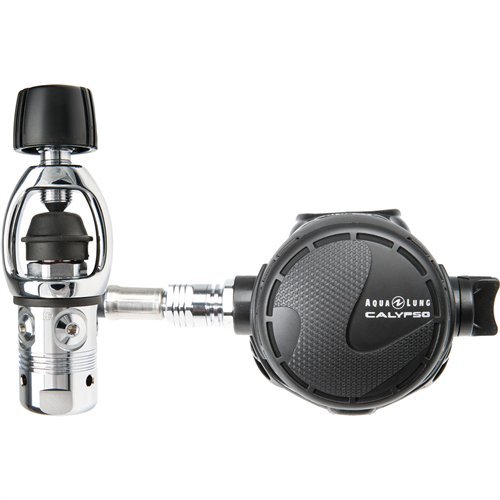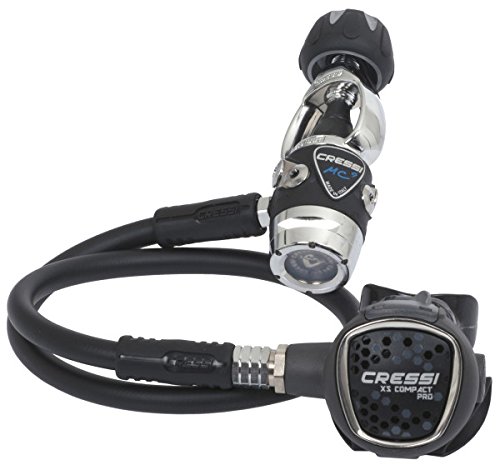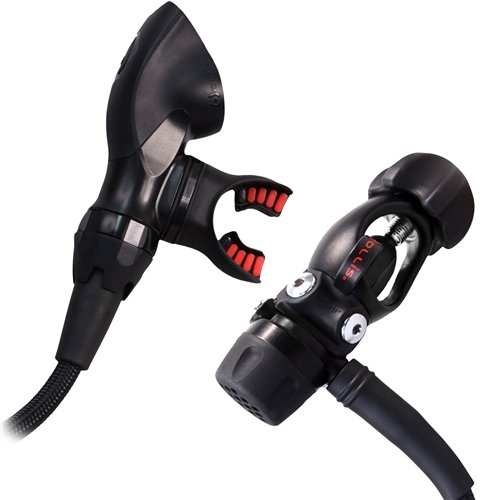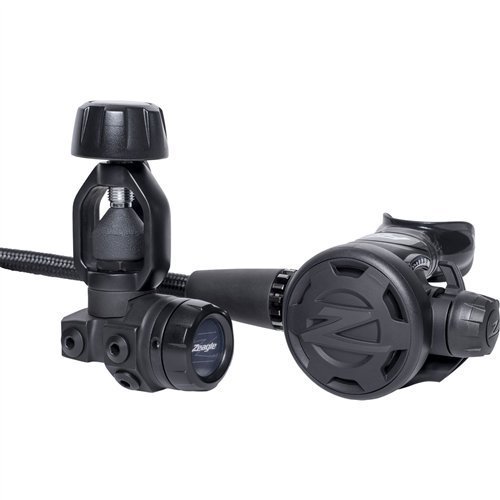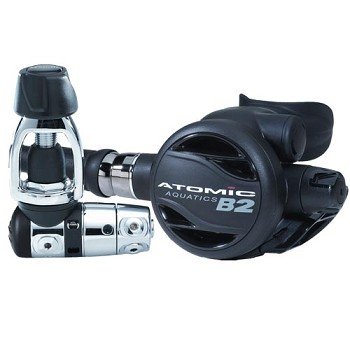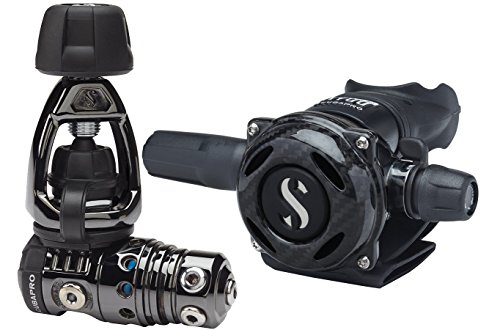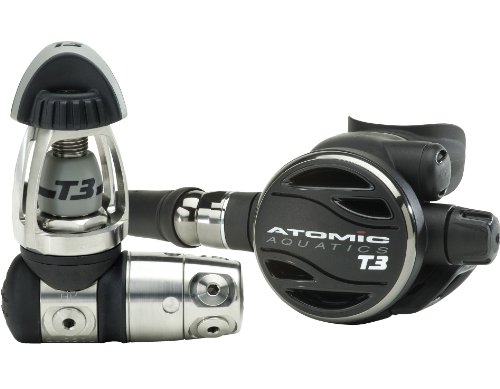A high-quality regulator is the most important piece of gear you can buy as a SCUBA diver because it allows you to breathe underwater. That’s why most divers make it their first equipment purchase! But, with hundreds of designs to choose from, you might not know what “reg” to choose. If you need some help shopping, this article is for you. We’ll walk you through the best SCUBA Regulators on the market, and all the top features and considerations to keep in mind when comparing models. Keep reading to learn more.
For more of our top scuba gear recommendations, check out these popular articles:
Warm Water Regulators | Cold Water Regulators | Regulators for Travel
Quick Answer - The Best Scuba Regulators
- Aqua Lung Calypso
- Scubapro MK2 EVO/R195
- Cressi XS Compact Pro MC9 SC
- Apeks XTX50
- Hollis DC7 500SE
- Zeagle F8
- Atomic B2 Swivel
- Scubapro MK25 EVO/A700
- Atomic Aquatics T3
Comparison Table - Best Scuba Regulator
For the best experience turn your device horizontally| Name | First Stage Type | Weight | Ports | Price | Rating | Review |
|---|---|---|---|---|---|---|
| Aqua Lung Calypso | Unbalanced Piston | 2.5 lbs | 4 Low Pressure, 1 High Pressure | $ | 4.4 | Read Review |
| Scubapro MK2 EVO/R195 | Unbalanced Piston | 2 lbs | 4 Low Pressure, 1 High Pressure | $ | 4.7 | Read Review |
| Cressi XS Compact Pro MC9 SC | Balanced Diaphragm | 2.1 lbs | 4 Low Pressure, 2 High Pressure | $ | 4.6 | Read Review |
| Apeks XTX50 | Balanced Diaphragm | 2.7 lbs | 4 Low Pressure, 2 High Pressure | $$ | 4.7 | Read Review |
| Hollis DC7 500SE | Balanced Diaphragm | 2.4 lbs | 4 Low Pressure, 2 High Pressure | $$ | 4.8 | Read Review |
| Zeagle F8 | Balanced Diaphragm | 2.6 lbs | 5 Low Pressure, 2 High Pressure | $$ | 4.8 | Read Review |
| Atomic B2 Swivel | Balanced Piston | 2.5 lbs | 5 Low Pressure, 2 High Pressure | $$$ | 4.8 | Read Review |
| Scubapro MK25 EVO/A700 | Balanced Piston | 2.4 lbs | 5 Low Pressure, 2 High Pressure | $$$ | 4.8 | Read Review |
| Atomic Aquatics T3 | Balanced Piston | 1.6 lbs | 5 Low Pressure, 2 High Pressure | $$$ | 5.0 | Read Review |
| Name | First Stage Type | Weight | Ports | Price | Rating | Review |
Reviews - The Best Regulators for Scuba Diving
Aqua Lung Calypso
Specs
- Weight: 2.5 lbs
- Ports: 4 Low Pressure, 1 High Pressure
- First Stage Type: Unbalanced Piston
Features
- Rated for Cold Water (below 50° F)
- Adjustable Flow (allows you to control how much air you receive in each breath)
- Pre-Dive Switch (reduces flow to conserve air on the surface)
BEST FOR: BUDGET
Are you shopping on a budget? The Aqua Lung Calypso is an entry-level regulator, so it’s perfect for newly certified divers, and it won’t break the bank! This model is a favorite for rental equipment thanks to its robust construction and easy to service design. Plus, it weighs less than most regulators in its class, so it’s a practical choice for dive travel, too. Keep in mind that this regulator features an unbalanced piston first stage, so it’s best for warm water use.
Scubapro MK2 EVO/R195
Specs
- Weight: 2 lbs
- Ports: 4 Low Pressure, 1 High Pressure
- First Stage Type: Unbalanced Piston
Features
- Adjustable Flow (allows you to control how much air you receive in each breath)
- Pre-Dive Switch (reduces flow to conserve air on the surface)
- Travel Weight (2.5 lbs or less)
BEST FOR: BEGINNERS
The Scubapro MK2 EVO/R195 features everything you need and nothing you don’t, so it’s a perfect pick for newly certified divers. It is rated for cold, light enough for dive travel, and has very few moving parts and pieces. This model isn’t super stylish, but it’s one of the best values around, dollar for dollar. Plus, thanks to its sturdy design, you can expect this “reg” to last for years to come. If you decide to upgrade your gear later, the Mk2 will make for a great backup.
Cressi XS Compact Pro MC9 SC
Specs
- Weight: 2.1 lbs
- Ports: 4 Low Pressure, 2 High Pressure
- First Stage Type: Balanced Diaphragm
Features
- Rated for cold water (below 50° F)
- Pre-Dive Switch (reduces flow to conserve air on the surface)
- Wireless Air Integration (an extra port for Bluetooth transmitters)
- Travel Weight (2.5 lbs or less)
BEST FOR: DIVE TRAVEL
If your plans include dive travel, you’ll want to shop for the most lightweight equipment available. But, it’s important to keep quality a top focus. The Cressi Compact Pro is affordable, well built, and one of the lightest options around. This makes it a top pick for beginners and budget shoppers, as well as globetrotters. This regulator features plenty of extra ports, so it’s easy to use with a dry suit or wireless dive computer. Plus, it’s rated for both warm and cold water.
Apeks XTX50
Specs
- Weight: 2.7 lbs
- Ports: 4 Low Pressure, 2 High Pressure
- First Stage Type: Balanced Diaphragm
Features
- Turreted First Stage (more versatile than a traditional valve)
- Adjustable Exhaust System
- Wireless Air Integration (an extra port for Bluetooth transmitters)
- Can be Configured for Sidemount or Double Tanks
BEST FOR: BUILT TO LAST
The Apeks XTX50 is a mid-range regulator built strong enough to use below the recreational diving limit (130 feet) and in full overhead environments like caves and shipwrecks. This model is rated for cold climates, and comes standard with a turreted first stage and plenty of ports, so it’s easy to incorporate into a sidemount or doubles (two back mounted tanks) setup. The XTX50 is hardly the most stylish option around and weighs more than similar models. But, its near-perfect performance and incredibly solid design make it a top pick for advanced divers and those who are hard on their gear.
Hollis DC7 500SE
Specs
- Weight: 2.4 lbs
- Ports: 4 Low Pressure, 2 High Pressure
- First Stage Type: Balanced Diaphragm
Features
- Rated for Cold Water (below 50° F)
- Wireless Air Integration (an extra port for Bluetooth transmitters)
- Can be Configured for Sidemount or Doubles
- Lightweight Braided Hoses Included
BEST FOR: UNDERWATER PHOTOGRAPHERS
Have you ever taken the perfect picture, only to discover that it’s full of distortions like backscatter and turbidity? The bubbles you exhale while scuba diving can cause water disturbance, and ruin even the best of shots. To combat this issue, the Hollis DC7 features a side exhaust to keep your bubbles well out of frame. Plus, it’s lightweight enough for dive travel, rated for cold water, and suitable for technical diving. This model also comes standard with super light, flexible hoses, and a soft mouthpiece, to help fight jaw fatigue.
Zeagle F8
Specs
- Weight: 2.6 lbs
- Ports: 5 Low Pressure, 2 High Pressure
- First Stage Type: Balanced Diaphragm
Features
- Adjustable Flow (allows you to control how much air you receive in each breath)
- Pre-Dive Switch (reduces flow to conserve air on the surface)
- Rated for Cold Water (below 50° F)
- Turreted First Stage (more versatile than a traditional valve)
- Wireless Air Integration (an extra port for Bluetooth transmitters)
BEST FOR: COLD CLIMATES
The Zeagle F8 is one of the most versatile regulators on the market no matter what climate you’re diving in. It features an environmentally sealed and insulated first stage and a self-heating second stage. This prevents stressful situations like freezing and freeflow underwater. Its large knobs and controls for customizing airflow are easy to grip, even while wearing thick gloves. Plus, its turreted first stage makes incorporating a dry suit or wireless computer simple. Even with all these perks, the F8 weighs less than most similarly designed models.
Atomic B2 Swivel
Specs
- Weight: 2.5 lbs
- Ports: 5 Low Pressure, 2 High Pressure
- First Stage Type: Balanced Piston
Features
- Swiveling Joints (to keep your head comfortable on long dives)
- Turreted First Stage (more versatile than a traditional valve)
- Wireless Air Integration (an extra port for Bluetooth transmitters)
- Requires Less Frequent Servicing
BEST FOR: COMFORT
The Atomic Aquatics B2 is one of the most comfortable regulators on the market. It includes plenty of ergonomic features like a turreted first stage, swiveling joints, and a second stage so light that it almost floats. This model has plenty of ports, so routing your hoses will be a breeze, no matter what the rest of your SCUBA setup looks like. Plus, the B2 can go 2 years or 300 dives before its first service, so you’ll save a bundle on maintenance.
Scubapro MK25 EVO/A700
Specs
- Weight: 2.4 lbs
- Ports: 5 Low Pressure, 2 High Pressure
- First Stage Type: Balanced Piston
Features
- Rated for Cold Water (below 50° F)
- Turreted First Stage (more versatile than a traditional valve)
- Wireless Air Integration (an extra port for Bluetooth transmitters)
- Can be Configured for Sidemount or Double Tanks
BEST FOR: CAVE, CAVERN, AND WRECK DIVERS
Few regulators feature as many diver friendly details as the ScubaPro MK 25 EVO/A700. This model is “easy breathing” even at extreme depths, rated for freezing conditions, and can be configured for sidemount and doubles (two back mounted tanks). That’s why technical divers prefer it over similar models in its class. The MK 25 EVO/A700 also features nearly unbreakable first and second stages, so it is sure to stand the test of time. And, best of all, it weighs less than most models designed specifically for travel.
Atomic Aquatics T3
Specs
- Weight: 1.6 lbs
- Ports: 5 Low Pressure, 2 High Pressure
- First Stage Type: Balanced Piston
Features
- Rated for Cold Water (below 50° F)
- Turreted First Stage (more versatile than a traditional valve)
- Swiveling Joints (to keep your head comfortable on long dives)
- Travel Weight (2.5 lbs or less)
- Includes a Padded Travel Case
- Requires Less Frequent Servicing
BEST FOR: BEST OF THE BEST
When it comes to SCUBA regulators, the Atomic Aquatics T3 is the top of the line. This model comes standard with high-end features like a turreted first stage and swiveling joints for easy hose routing and comfort. It’s rated for extreme dive environments like freezing water, caves and caverns, and shipwrecks. Plus, it’s one of the most lightweight options available and includes a padded travel case. The T3 only requires service every 3 years or 300 dives, so you won’t waste time and money on maintenance.
THINGS TO CONSIDER WHEN BUYING A SCUBA REGULATOR
WATER TEMPERATURE
If your diving aspirations include taking the plunge into temperatures below 75º F, choose a regulator that is rated for cold climates. While a standard regulator will work just as well in temperatures as low as 50º F, it’s a good idea to take the extra precaution. You never know when you could encounter a cold current or thermocline. Plus, regulators designed for cold water tend to be robust, hard wearing, and sealed against exterior contaminants.
WEIGHT
These days, more and more divers are traveling to explore new underwater environments. And, when it comes to air travel, every pound of equipment counts. But, you should keep quality as your top priority while shopping, even if you are looking for a travel regulator (under 2.5 lbs).
Your regulator should feel rugged and sturdy, no matter what it weighs. Avoid flimsy plastic parts, tiny knobs, and any material that feels overly flexible or fragile. If you are hoping to cut down on your gear bag‘s weight, keep an eye out for regulators made from lightweight materials like titanium and carbon fiber. You can also reduce your regulator’s overall weight by using woven hoses instead of rubber, and a smaller pressure gauge.
BUDGET
If you’re new to diving, you might not want to spend a ton on your first regulator. And, that’s OK! There are plenty of high-quality regulators available, no matter what your budget is.
If cost is a major factor for you, start by selecting a few similarly priced models within your budget. Then, compare their features. You should purchase the regulator that best suits your diving needs, even if you need to wait a few extra months to buy it. Never cut corners on construction or craftsmanship to save a few dollars.
Although they may seem like a good deal, regulator “bundles” that include an alternate air source and pressure gauge aren’t always a good value. Your best bet is to handpick these items individually.
DIN OR YOKE VALVE
Regulators come with one of two standard valve types, DIN or Yoke. Which is best for you depends on your diving interests and experience level.
A DIN valve is best for technical diving, cold water immersions, and exploring overhead environments like wrecks and caves. Because this valve type screws directly onto your scuba tank, it forms a secure seal. However, the DIN valve’s external threads are sensitive to wear and tear. This means you’ll need to take more care during setup and breakdown, and thoroughly wash and dry the valve after every use.
Most warm water divers prefer to use a Yoke valve. This is the most common regulator configuration in the United States, Canada, and Latin America. The Yoke valve attaches to your SCUBA tank using a rubber O-ring. This type of seal is less stable than the DIN valve, but it’s perfectly safe for most recreational uses. This valve type is also popular because it’s so easy to set up and break down, and far less fragile than its DIN counterparts.
BALANCED OR UNBALANCED
For warm water and recreational divers, the primary difference between a balanced and unbalanced regulator is how it “breathes.” This term refers to a change in airflow when you are low on air.
A balanced regulator will deliver the same airflow with every breath, up until the point that your tank is empty. An unbalanced regulator will provide a lower airflow as your tank pressure drops. This change in breathing can be a helpful reminder to check your pressure gauge before you run out of air. If you are diving in cold conditions or exceeding the recreational dive limits (40 meters), you should use a balanced regulator. A change in airflow can be unsafe during more challenging immersions.
PISTON OR DIAPHRAGM
Piston and diaphragm regulators work the same way, but use a different mechanism to deliver air. In both types, gas from your tank enters the regulator’s first stage, where it forces either a piston or a diaphragm open and closed as you breathe. For most recreational divers in warm water, there is little difference between the two.
Piston first stages offer a higher flow rate of air, so they are considered “easier breathing” than their diaphragm counterparts. Piston regulators are also easier to service because they have a basic internal design with few moving pieces.
Diaphragm first stages offer a lower flow rate and are less likely to freeflow. Diaphragm regulators are also often environmentally sealed in an airtight, insulated exterior, making them less likely to freeze over. That’s why technical and cold water divers prefer them.
NUMBER OF PORTS
Your regulator’s first stage can never have too many ports (attachment points for high and low pressure hoses). Most basic models come standard with 4 low pressure ports (for second stages, BCD inflator hoses, and dry suits) and 1 high pressure port (for pressure gauges and wireless air integrated dive computers). This setup is fine for entry-level divers, but you may want to use more attachment points in the future. Because extra ports can’t be added later, you should choose a model with more than you think you’ll use.
FEATURES EXPLAINED
RATED FOR COLD WATER (BELOW 50° F)
If you’re planning to dive in temperatures below 50° F, you should buy a regulator rated for cold climates. These specially designed models include features that prevent them from freeflowing and freezing.
Most cold water regulators use a balanced diaphragm first stage, and an environmental seal (air- and water-tight insulating exterior). Some cold water divers prefer a DIN valve because it forms a more secure seal than the Yoke valve. Some models also include self-heating elements in the second stage to keep your mouth comfortable while diving in cool climates. Cold water regulators work just as well in warm water, so there is no need to buy a second set of “regs” if you aren’t exclusively diving in cold conditions.
ADJUSTABLE FLOW
If you plan to dive in challenging conditions, you’ll want a regulator that’s up to the task. Adjustable airflow allows you to increase and decrease the amount of air delivered per breath by turning an external knob. This will enable you to conserve air during less demanding dives and helps fight fatigue by providing extra air when you need it.
PRE-DIVE SWITCH
A pre-dive switch allows you to reduce your regulator’s air flow. This makes it easy to prevent freeflow as you enter the water and while you wait on the surface. This feature reduces stress before descent and helps conserve air. A pre-dive switch is especially helpful if you are diving in adverse surface conditions like waves and surge.
ADJUSTABLE EXHAUST SYSTEM
Adjustable exhaust systems let you control the stream of bubbles that you exhale while diving. This feature is especially useful if you are an underwater photographer because it reduces disturbance in the water around you. Fewer bubbles close to your camera mean a decrease in backscatter and turbidity, which can improve the clarity of your shots.
TURRETED FIRST STAGE
A turret is a vertical, tower-shaped first stage. Some divers find this setup more comfortable and versatile than a traditional horizontal valve because it allows for easy and ergonomic routing of your hoses. Turreted first stages are more practical for technical, dry suit, and sidemount divers.
SWIVELING JOINTS
Some regulators use a swiveling joint to attach the second stage to its hose. This extra flexibility prevents jaw fatigue because it reduces tension in your regulator’s hose and keeps it from tugging against your mouth. Swiveling joints also allow for a greater range of motion underwater and prevent strain in your head and neck.
WIRELESS AIR INTEGRATION
If you want to add an air integrated dive computer to your SCUBA setup, you’ll need a regulator with 2 high-pressure ports. Wireless dive computers use a Bluetooth transmitter that attaches to your regulator’s first stage. This transmitter reads tank pressure just like a traditional pressure gauge. Then, it relays this information to a wrist-mounted display. If you’re using a wireless computer, your “reg” should also include a standard depth gauge in case of equipment error or failure.
READ MORE
For more of our top scuba diving gear recommendations, check out these popular buyer's guides:

